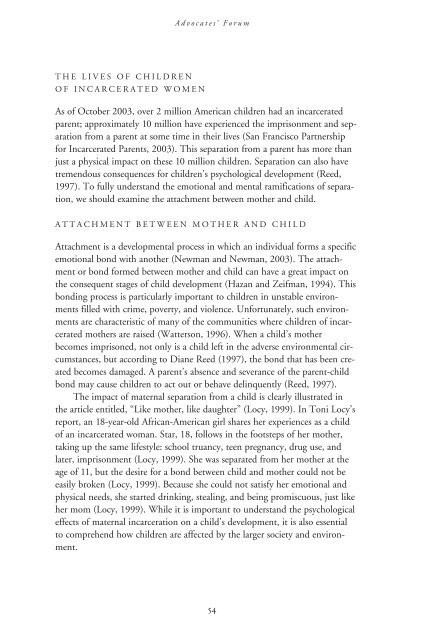2004 - School of Social Service Administration - University of Chicago
2004 - School of Social Service Administration - University of Chicago
2004 - School of Social Service Administration - University of Chicago
Create successful ePaper yourself
Turn your PDF publications into a flip-book with our unique Google optimized e-Paper software.
Advocates’ Forum<br />
THE LIVES OF CHILDREN<br />
OF INCARCERATED WOMEN<br />
As <strong>of</strong> October 2003, over 2 million American children had an incarcerated<br />
parent; approximately 10 million have experienced the imprisonment and separation<br />
from a parent at some time in their lives (San Francisco Partnership<br />
for Incarcerated Parents, 2003). This separation from a parent has more than<br />
just a physical impact on these 10 million children. Separation can also have<br />
tremendous consequences for children’s psychological development (Reed,<br />
1997). To fully understand the emotional and mental ramifications <strong>of</strong> separation,<br />
we should examine the attachment between mother and child.<br />
ATTACHMENT BETWEEN MOTHER AND CHILD<br />
Attachment is a developmental process in which an individual forms a specific<br />
emotional bond with another (Newman and Newman, 2003). The attachment<br />
or bond formed between mother and child can have a great impact on<br />
the consequent stages <strong>of</strong> child development (Hazan and Zeifman, 1994). This<br />
bonding process is particularly important to children in unstable environments<br />
filled with crime, poverty, and violence. Unfortunately, such environments<br />
are characteristic <strong>of</strong> many <strong>of</strong> the communities where children <strong>of</strong> incarcerated<br />
mothers are raised (Watterson, 1996). When a child’s mother<br />
becomes imprisoned, not only is a child left in the adverse environmental circumstances,<br />
but according to Diane Reed (1997), the bond that has been created<br />
becomes damaged. A parent’s absence and severance <strong>of</strong> the parent-child<br />
bond may cause children to act out or behave delinquently (Reed, 1997).<br />
The impact <strong>of</strong> maternal separation from a child is clearly illustrated in<br />
the article entitled, “Like mother, like daughter” (Locy, 1999). In Toni Locy’s<br />
report, an 18-year-old African-American girl shares her experiences as a child<br />
<strong>of</strong> an incarcerated woman. Star, 18, follows in the footsteps <strong>of</strong> her mother,<br />
taking up the same lifestyle: school truancy, teen pregnancy, drug use, and<br />
later, imprisonment (Locy, 1999). She was separated from her mother at the<br />
age <strong>of</strong> 11, but the desire for a bond between child and mother could not be<br />
easily broken (Locy, 1999). Because she could not satisfy her emotional and<br />
physical needs, she started drinking, stealing, and being promiscuous, just like<br />
her mom (Locy, 1999). While it is important to understand the psychological<br />
effects <strong>of</strong> maternal incarceration on a child’s development, it is also essential<br />
to comprehend how children are affected by the larger society and environment.<br />
54
















